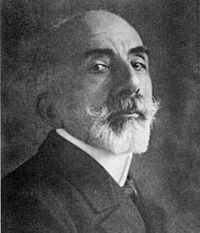Corrado Segre facts for kids
Quick facts for kids
Corrado Segre
|
|
|---|---|
 |
|
| Born | 20 August 1863 Saluzzo, Italy
|
| Died | 18 May 1924 (aged 60) Turin, Italy
|
| Nationality | Italian |
| Known for | Segre classification Segre cubic Segre embedding Segre surface Zeuthen–Segre invariant |
| Scientific career | |
| Fields | Mathematics |
| Doctoral students | Gino Fano Beppo Levi Beniamino Segre Francesco Severi |
Corrado Segre was an important Italian mathematician. He was born on August 20, 1863, and passed away on May 18, 1924. He is famous for helping to create a special area of math called algebraic geometry. This field uses algebra to study geometric shapes.
Contents
Early Life and Education
Corrado Segre's parents were Abramo Segre and Estella De Benedetti. He grew up in Saluzzo, Italy.
He studied at the University of Turin in Italy. There, he was a student of a well-known mathematician named Enrico D'Ovidio.
A Career in Mathematics
Corrado Segre spent his entire career at the University of Turin.
Starting His Journey
In 1883, when he was just 20 years old, Segre published his first important work. It was about shapes called quadrics in a special kind of space called projective space. After this, he became an assistant professor. He helped teach algebra and a type of math called analytic geometry. Later, he also helped with descriptive geometry.
Becoming a Professor
From 1885 to 1888, Segre taught projective geometry. He filled in for another professor, Giuseppe Bruno. Then, for 36 years, he held the main teaching position in higher geometry. He took over this role from his former teacher, Enrico D'Ovidio.
Turin: A Center for Geometry
Segre and another mathematician named Giuseppe Peano made the University of Turin famous for geometry. They had different but helpful ways of teaching. People said that these two young researchers were developing very advanced ideas about geometry. Their work made Turin a special place for studying these topics.
Spreading New Ideas
Segre was very interested in the "Erlangen program" by Felix Klein. This program was a new way to think about geometry using group theory. In 1885, Segre wrote an article showing how group theory could help study shapes called conics.
He believed that more young Italian mathematicians should know about Klein's ideas. So, Segre convinced one of his students, Gino Fano, to translate the "Erlangen Program" into Italian. This translation was published in 1889 and was the first of many translations of Klein's important work.
Segre also encouraged another mathematician, Mario Pieri, to translate a book called Geometrie der Lage by Karl Georg Christian von Staudt. Segre even wrote a short biography of von Staudt for the translated book.
Expanding Algebraic Geometry
Segre also explored new types of numbers called multicomplex numbers, especially bicomplex numbers. In 1892, he published work that built on the ideas of mathematicians like William Rowan Hamilton. His work helped expand the field of algebraic geometry.
Inspiring Future Mathematicians
One of Segre's well-known works in English is an essay he wrote for Italian students. It was translated in 1904. This essay offered guidance and encouragement to young people studying mathematics. It showed his dedication to helping the next generation.
Father of a School of Thought
In 1926, a mathematician named H.F. Baker called Corrado Segre the "father" of the Italian school of algebraic geometry. This means Segre played a huge role in shaping how algebraic geometry was studied and taught in Italy.
His 1912 article, "Higher-dimensional Space," was a massive 200-page work for a famous encyclopedia. People admired it for being very complete and recognizing the work of many other mathematicians. It was seen as a monument to his broad understanding.
See also
 In Spanish: Corrado Segre para niños
In Spanish: Corrado Segre para niños

